Nowadays, a similar experience is felt by many individuals, where they're hit over and over again by tidal waves of marketing messages on every channel out there. Not only is it annoying AF, but it's making it hard for businesses to cut through the advertising noise and reach their people. For most marketers, there is a universal sentiment that more personalised, targeted messages on the right channels at the right moment are key to breaking out of the clutter, however, the trouble is figuring out how to do this. Enter stage left, conversational marketing.
This isn’t just some 'New-age' jargon, Harold.
At its core, Conversational marketing, a relatively new brainchild of contemporary marketing, helps businesses create more meaningful relationships with their customers through dialogue and messaging that is delivered how consumers want, where they want and then they want.
Conversational Marketing is helping companies bridge the gap from the physical to the digital world and create personal relationships at scale
- Sara Varnia, CMO of Twilio.
And as more companies do their business online, even forgoing a brick and mortar storefront all together, digital conversational tactics are essential for delivering customers an experience that, for ages, was only thought to be experienced through face-to-face discussion.
So you're probably now thinking, "Alright, conversational marketing may have some merit for my business, but I'm not totally convinced that its something I should consider right now." Well, here are some super important reasons about why you should implement a conversational strategy in your marketing practice now:
People are already communicating with brands online (duh).
People today have choice when it comes to how they talk to brands. Rather than in-person meetings, phone calls or submitting forms, people can talk to businesses through channels that work best for them.
Interactive Messaging platforms, like Facebook messenger, Whats app, Google hangouts, Slack, etc, are just some channels that are becoming popular interfaces for buyer inquiries. Facebook IQ found that:
- 56% of people prefer to message rather than call a business.
- 61% are favourable to personal messages from businesses.
More than 50% of buyers are more likely to shop with a business they can message. - 61% reported that their messaging with businesses is increasing.
Experts also predict that customer engagement on messenger apps will surpass social media engagement. Why? Because people want to feel connected to a business. Messaging platforms provide space for that to happen because it enables continuous brand engagement with real-time consumer interactions. And with 7 million people in Australia on these messaging apps, these platforms are conversion opportunity goldmines.
On another note, 83% of people prefer engaging with brands directly on their websites. Chat automation, i.e chatbots and live-chat, are conversational marketing tactics you can use to optimise on this phenomenon. These interfaces let people find what they're looking for on websites quickly, rather than scrolling and clicking page after page for what feels like forever. In other words, this tech makes it easy for brands to turn random visitors into prospects by identifying potential leads, sparking their interest in products and developing customer and brand relations. And just to add another cherry to this sundae, companies that use chatbots alone have seen their visitor-to-lead conversion rate increase by 10%. Therefore, having a well-planned conversation marketing strategy is kinda important if you want to get those sweet conversions.
Get closer to your audience
As hinted above, marketers nowadays have to be accessible to their targeted audience through many (maybe too many) channels, including mobile, social, email and digital. Using a conversational marketing approach that standardises and personalises brand messaging is key to seamlessly reaching all facets of your audience. According to Harvard Business Review, messaging apps “provide a continuous thread between customers and brands”. This thread establishes a conversational passage between parties that feels more natural and encourages "opportunities to cross-sell, encourage sharing, solicit input, and flow seamlessly between commerce and support”.
Moreover, during these conversational ebbs and flows, brands have a chance to strengthen their reputation. The way you communicate tells people a lot about who you are as a business, how you operate and what you stand for. More than anything, its a way of showcasing brand personality. Research shows that repeated and transparent interactions between customers and brands strengthen their relationships, positively affecting brand image and identity. Therefore, getting your messaging right is necessary for generating authentic brand-consumer relationships.
All aboard to Feedback central.
Talking 1-1 with your customers is the best way to get actually helpful, qualitative feedback. They'll tell you in their own words how they want to engage with your company, no wishy-washy guessing or hypothesising needed. Also, with conversational marketing, you get data at scale. Chat interfaces can record data that, when extrapolated, help you find better customer interaction solutions, product enhancements, useful content and more. And social media in particular gives you cost-effective and real-time access to your audiences' unfiltered and untouched opinions and assumptions.
To give you an idea on how to use Conversational marketing in your business, here are some real-life examples:
Even though its a bit of an oldie, Domino's AnyWare initiative is still a goodie. The campaign, released in 2015, made it possible for customers to order pizza on any platform that works for them - Apple TV, Google Home, Amazon Echo, Ford Sync, SMS, an in-app voice assistant, as well as via Tweets, Slack, and Facebook messenger.
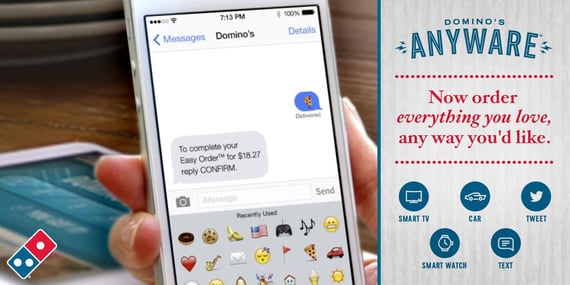
Since then, the Australian Dominos branch also introduced their Dominos Anywhere campaign (note that its 'where' not 'ware'). Customers can get their pizza delivered to them no matter how obscure their location is by using the Domino's mobile app. And apparently there have been some very unusual pickup spots, including sides of roads in the middle of nowhere, parliament house, cherry pickers and the Australian Royal Navy base. Imagine the poor guy who had to walk into a heavily guarded, militarised zone to delivery a meat lovers and cheeky margarita.
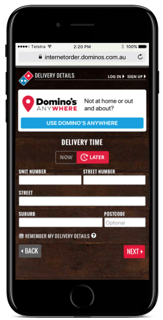
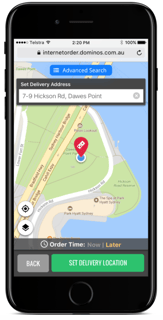
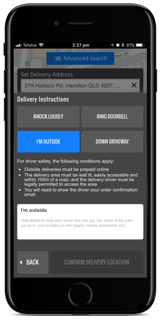
Understanding that their customers' want convenience, Domino's strategies provide a simple, yet delightful solution for people to get what they, want no matter what device they have on hand or where they are.
Libra, an Aussie female hygiene retailer, created their own online forum, Girl Chat, for one of their key target markets, girls aged 9-16. Girls can ask questions about their periods, libra products, and other topics like school, love and family. Libra representatives or other customers provide solutions and posts are then archived for future reference. By creating an consumer- accessible, short-answer forum, Libra is able to provide relevant answers to their audience in a personal and empathetic way. This enables the brand to form a long-lasting customer-brand bonds, built on trust and shared knowledge.
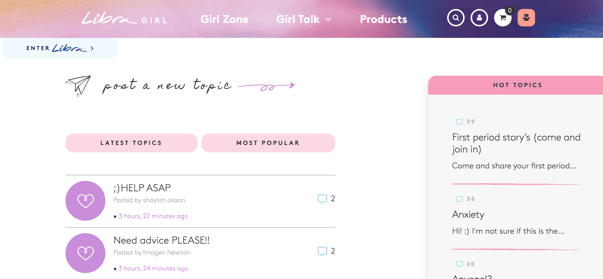
HelloFresh, a subscription meal service, launched Freddy Freshbot chatbot in 2017. Freddy provides customer service, recipe ideas, answers FAQ's and meal reminders, delighting customers with a service that exceeds their expectations and encourages subscription renewals.
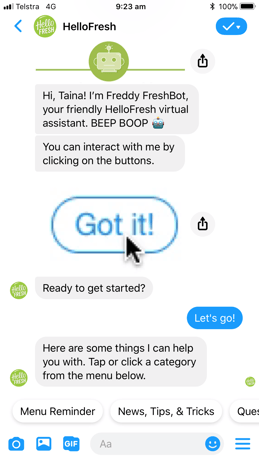
An Inbound marketer walks into a conversation...
Before you dabble in conversational marketing, you should know that conversational marketing is an ever-evolving process. It takes time to develop, like most marketing strategies, but Hupspot's Brian Bagdasarian created a really good framework to build your strategy from: S.C.O.P.E.
- Standardise: Can elements of your conversations be repeated? Standardising dialogue, meaning that some responses are the same in most situations, ensures voice, content and strategy are consistent and brings a level professionalism to every interaction.
- Contextualise: Context is important for making sure you deliver the right answer to the right situation. It helps create a positive end-user experience and minimises misunderstandings by getting to the crux of the issue. How you create context depends on your analysis of customer interactions you already commonly have.
- Optimise: This is about delivering the right info through the right channel to optimise the conversations you are having with your audience. For instance, using livechat and chatbots for providing support and answering FAQ's, while using Facebook Messenger for content distribution. Not only optimise the strengths of a channel, but also consider how you can optimise you answers to be to the point, while adding value.
- Personalise: Cater information for the individual to make conversations feel more organic and get to the heart of the issue efficiently.
- Empathise: Be human. Acknowledge your customer's problem before giving them a solution. Showing you feel for their situation helps them feel valued and heard.
Conversational marketing is making the way companies interact with their people better and faster than ever before. Your audience is already talking to you, so why not join the discussion? Great chat y'all and good luck.

